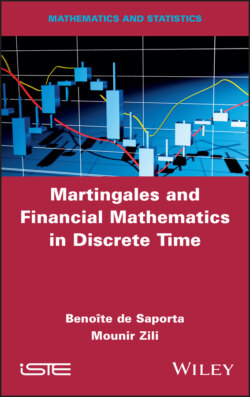Martingales and Financial Mathematics in Discrete Time

Реклама. ООО «ЛитРес», ИНН: 7719571260.
Оглавление
Benoîte de Saporta. Martingales and Financial Mathematics in Discrete Time
Table of Contents
List of Illustrations
List of Tables
Guide
Pages
Martingales and Financial Mathematics in Discrete Time
Preface
Introduction
1. Elementary Probabilities and an Introduction to Stochastic Processes
1.1. Measures and σ-algebras
1.2. Probability elements
1.2.1. Probabilities
1.2.2. Random variables
1.2.3. σ-algebra generated by a random variable
1.2.4. Random vectors
1.2.5. Convergence of sequences of random variables
1.3. Stochastic processes
1.4. Exercises
2. Conditional Expectation
2.1. Conditional probability with respect to an event
2.2. Conditional expectation
2.2.1. Definitions
2.2.2. Properties of conditional expectation
2.3. Geometric interpretation
2.4. Conditional expectation and independence
2.5. Exercises
3. Random Walks
3.1. Trajectories of the random walk
3.1.1. Definition
3.1.2. Graphical representation
3.1.3. Reflection principle
3.2. Asymptotic behavior
3.2.1. The Markov property and stationarity property
3.2.2. First return to 0
3.3. The Gambler’s ruin
3.4. Exercises
4. Martingales
4.1. Definition
4.2. Martingale transform
4.3. The Doob decomposition
4.4. Stopping time
4.5. Stopped martingales
4.6. Exercises
5. Financial Markets
5.1. Financial assets
5.2. Investment strategies
5.3. Arbitrage
5.4. The Cox, Ross and Rubinstein model
5.5. Exercises
5.6. Practical work
5.6.1. Simulation of trajectories
5.6.2. Portfolio optimization
5.6.3. Portfolio optimization with withdrawal
6. European Options
6.1. Definition
6.2. Complete markets
6.3. Valuation and hedging
6.4. Cox, Ross and Rubinstein model
6.4.1. Completeness
6.4.2. Value of European options
6.4.3. Hedging European options
6.5. Exercises
6.6. Practical work: Simulating the value of a call option
7. American Options
7.1. Definition
7.2. Optimal stopping
7.2.1. Snell envelope and stopping time
7.2.2. Construction of optimal stopping times
7.3. Application to American options
7.4. The Cox, Ross and Rubinstein model
7.4.1. Value of American options
7.4.2. Hedging American options
7.5. Exercises
7.6. Practical work
8. Solutions to Exercises and Practical Work. 8.1. Solutions to exercises in Chapter 1. 8.1.1. Exercise 1.1
8.1.2. Exercise 1.2
8.1.3. Exercise 1.3
8.1.4. Exercise 1.4
8.1.5. Exercise 1.5
8.1.6. Exercise 1.6
8.1.7. Exercise 1.7
8.1.8. Exercise 1.8
8.2. Solutions to exercises in Chapter 2. 8.2.1. Exercise 2.1
8.2.2. Exercise 2.2
8.2.3. Exercise 2.3
8.2.4. Exercise 2.4
8.2.5. Exercise 2.5
8.2.6. Exercise 2.6
8.2.7. Exercise 2.7
8.2.8. Exercise 2.8
8.2.9. Exercise 2.9
8.2.10. Exercise 2.10
8.2.11. Exercise 2.11
8.2.12. Exercise 2.12
8.3. Solutions to exercises in Chapter 3. 8.3.1. Exercise 3.1
8.3.2. Exercise 3.2
8.3.3. Exercise 3.3
8.3.4. Exercise 3.4
8.3.5. Exercise 3.5
8.3.6. Exercise 3.6
8.3.7. Exercise 3.7
8.3.8. Exercise 3.8
8.4. Solutions to exercises in Chapter 4. 8.4.1. Exercise 4.1
8.4.2. Exercise 4.2
8.4.3. Exercise 4.3
8.4.4. Exercise 4.4
8.4.5. Exercise 4.5
8.4.6. Exercise 4.6
8.4.7. Exercise 4.7
8.4.8. Exercise 4.8
8.4.9. Exercise 4.9
8.4.10. Exercise 4.10
8.4.11. Exercise 4.11
8.5. Solutions to exercises in Chapter 5. 8.5.1. Exercise 5.1
8.5.2. Exercise 5.2
8.5.3. Exercise 5.3
8.5.4. Exercise 5.4
8.5.5. Exercise 5.5
8.6. Solutions to the practical exercises in Chapter 5
8.6.1. Practical exercise 5.6.1
8.6.2. Practical exercise 5.6.2
8.6.3. Practical exercise 5.6.3
8.7. Solutions to exercises in Chapter 6. 8.7.1. Exercise 6.1
8.7.2. Exercise 6.2
8.7.3. Exercise 6.3
8.7.4. Exercise 6.4
8.8. Solution to the practical exercise in Chapter 6 (section 6.6)
8.9. Solution to exercises in Chapter 7. 8.9.1. Exercise 7.1
8.9.2. Exercise 7.2
8.9.3. Exercise 7.3
8.10. Solution to the practical exercise in Chapter 7 (section 7.6)
References
Index
WILEY END USER LICENSE AGREEMENT
Отрывок из книги
Series EditorNikolaos Limnios
.....
If we consider an urn containing N indistinguishable balls, k red balls and N – k white balls, with k ∈ {1, ...N 1}, and if we simultaneously draw n balls, then the random variable X, equal to the number of red balls obtained, follows a hypergeometric distribution with parameters N, n and
EXAMPLE 1.17.– Poisson distribution: Let λ > 0 and X be a random variable on (Ω, , ℙ) such that
.....